Abstract
The dependence of water use efficiency (WUE) on changes in land cover types is crucial for understanding of long-term water availability and assessment of water-saving strategies. Investigating the impact of land cover types on ecosystem WUE has important implications when revealing water dynamics and land management. However, the determination of WUE and its dominant factors have always been subject to high data dependency and large calculation consumption within large basins. This paper proposes a framework for processing actual evapotranspiration (AET) and WUE calculation by coupling the Maximum Entropy Production (MEP) method with the Google Earth Engine (GEE). By employing the proposed framework and three data sources available in the GEE platform, results for actual ET and WUE from 2001 to 2020 were obtained in the Yellow River Basin (YRB). The results show that the proposed framework provides an acceptable estimation of actual ET via validation with Eddy Covariance flux sites in the YRB. The calculated WUE values varied greatly in different sub-basins within the YRB, indicating a cumulative growth rate of about 56% during the past 20 years. The dominant factor that led to these changes was the transition from Grasslands into other land-use types. Our results suggest that the use of the GEE platform coupled with the MEP method offers new possibilities for advancing understanding of water exchange and water resource management.
1. Introduction
Understanding ecosystem productivity responses to limited water resources is important worldwide, especially in water-constrained regions. Ecosystem water use efficiency (WUE) is defined as the ratio of gross primary productivity (GPP) to actual evapotranspiration (AET) and has long been used as an essential indicator of the water and carbon cycles [1,2]. By investigating ecosystem WUE and its spatial–temporal characteristics, different water resource management strategies can be designed by policymakers as well as by residents in different regions [3]. Several researchers have pointed out that land-use changes, precipitation, and temperature will likely alter ecosystem functions, as indicated by changes in the WUE [4,5,6,7,8]. Therefore, exploring the spatial–temporal characteristics and dominant factors of ecosystem WUE is of great significance for understanding the role of water-saving policies in ecosystem water use.
When determining WUE values in a region, it is vital to obtain a robust estimation of evapotranspiration (ET), which is an essential component of the water cycle and the central linkage between several fluxes [9,10]. Generally, the ET process is considered one of the most significant challenges in the hydro-meteorological processes, as it is hard to monitor and model due to the complex interactions in hydro-meteorological systems [11] and has important implications for many applications, such as agricultural management, water resources, etc. Both actual ET (AET) and potential ET (PET) are considered useful concepts for scientific and practical application [1]. Previous efforts to find a robust method for ET estimation have yielded many methods, including the lysimeter, Eddy Covariance (EC) system, energy balance Bowen ratio method, surface energy balance (SEB) model, and satellite retrieval methods [12,13,14,15,16,17,18]. However, it is challenging to get both AET and PET values at different scales [19,20,21,22]. In particular, it is complex to estimate ET accurately in large regions due to the required resolution and high-size input datasets [23]. For specific regions, such as the Yellow River Basin (YRB), satellite retrieval ET models with different simplifying assumptions, formulas, and constraints have been suggested as advantages in terms of time scale and time range [24,25,26]; however, it is time-consuming to obtain the satellite datasets required for large-scale models.
Recently, the maximum entropy production (MEP) method, which takes into account contemporary non-equilibrium thermodynamics, information theories, and Bayesian probability, has proven to be an effective method for ET estimation [27,28,29]. The advantages of the MEP method include that it (1) takes atmospheric and land surface conditions into account; (2) makes effective use of three input variables; and (3) can successfully estimate the evaporation and transpiration over different land cover and water conditions [28,29]. By considering different surface conditions, the MEP method can estimate both AET and PET [27]. In addition, the small number of input variables in the MEP method leads to increased attention when estimating ET values in large regions [30]. However, the MEP method is rarely applied in large areas due to the few publicly available steps for fast application. In addition, different methods of estimating uncertainties around ET have been widely reported [17]. For example, Timmermans et al. reported that the uncertainty of temperature differences resulted in the uncertainty of ET [31,32]. For actual ET estimation, it is believed to be necessary to investigate the uncertainties of all the multiple data sources [12]. The uncertainties in the modeled ET estimates may be sourced from multiple input remote sensing datasets or algorithms [33,34]. The input products generally consist of radiation variables, meteorological observations, and vegetation indices [35]. Therefore, it is meaningful to use many different data sources to examine the uncertainties in the procedure of ET estimation as well as the validation of ET methods. Alternatively, a cloud computing platform named the Google Earth Engine (GEE) facility stores and processes huge data sets for analysis and ultimate decision making [36]. In addition, GEE provides free access to many meteorological reanalysis data, satellite data, etc. This eliminates the obstacles of data acquisition and insufficient computing power of personal computers for scientific calculation [37]. However, it is difficult to realize the ET calculation and WUE determination by harnessing ET estimated methods within the GEE environment.
The main objective of the present study is to propose a framework for processing actual ET and WUE calculation as well as analyzing spatial–temporal and tendency characteristics by coupling the MEP method and GEE (hereafter referred to as “GEEMEP”) to take advantage of the GEE platform and MEP theory for robust estimation of AET and WUE values. The Yellow River Basin (YRB) was used to evaluate the performance of “GEEMEP” with different data sources and changes in land use. As China’s second-biggest river basin, the YRB contains more than 20% of China’s population and total GDP. Concerns about the ecosystem WUE in the YRB have led to many published works of literature [38]; the effects of land-cover changes on the hydrological cycle are considered to be very complicated in the YRB [39,40]. With the support of the GEE platform, AET values and WUE values can be calculated for the whole YRB and the characteristics of the WUE changes can be captured and counted, which is beneficial in obtaining a better understanding of the ecosystem WUE in the region. The knowledge obtained from this study will be helpful for effective WUE monitoring and building policy support.
2. Materials and Methods
2.1. Methodology
2.1.1. The Proposed Framework
A framework with the MEP method and GEE platform was proposed to calculate AET and WUE values and the outputs of statistical analysis. The flowchart and steps of this modeling framework are shown in Figure 1. First, the WUE was defined as the Gross Primary Production (GPP) ratio to actual evapotranspiration [41]. This definition is commonly used in water resources, with the assumption regarding the actual ET as the water loss of different ecosystems [42] due to the breakthrough of determination methods in GPP and actual ET during the past several years. Second, the GEE platform achieved easy data management and calculation processing with Python codes in this framework. Python was chosen to implement ET calculation using the Maximum Entropy Production method [43,44]. This enabled organization of the code into smaller pieces as modules and made it easier to reuse code. Third, the analysis and post-processing modules for this framework were designed.

Figure 1.
Flow chart of the framework based on Google Earth Engine platform for estimating the actual ET and Water Use Efficiency (WUE): (a) Datasets selected from GEE in this article; (b) Variables selected from datasets; (c) Processing of input data; (d) Implementation and outputs of MEP model; (e) The validation of results; (f) Statistics and analysis of the results.
As shown in Figure 1, the GEE platform facilitates GEE datasets, band selection, data processing, and calculation processes. Three reanalysis datasets were used in this study, as they provided the needed meteorological variables. It should be noted that other datasets with variables required for the MEP method can be used in this framework; details of the MEP method are provided in Section 2.1.2. By employing the “gee-python API” [45] in the GEE platform and Python 3.9, a Python package named “GEEMEP” was designed and formed to implement the steps in this framework. The input variables required for the MEP method were filtered out from the datasets, converted into Python objects through the “gee-python” API, and the MEP module called for calculation (as shown in the parts of the module in Figure 1a–d). By coupling the analysis and post-processing function (as shown in the parts of the module in Figure 1e,f), the framework proposed in this study can dynamically estimate WUE values depending on the datasets (i.e., land use/land cover, climate) available on the GEE platform. Table S1 in the Supplementary Materials shows the versions of Python and the main modules used in the “GEEMEP” package.
2.1.2. Maximum Entropy Production Method
The Maximum Entropy Production (MEP) method was derived by combining the maximum entropy theory (MaxEnt) with non-equilibrium thermodynamics in order to model evapotranspiration [46]. The entropy production function D can be defined as the sum of the dissipation function of the ground, sensible, and latent heat fluxes (as G ()(W·m−2), H (W·m−2) and E (W·m−2), respectively).
where , and (W·m−2·K−1·s1/2) are the thermal inertia parameters associated with the G, H, and E. Equation (1) is derived from the remaining energy balance constraints over a land surface. The formulations of , , and were derived by [27]. Therefore, a given net radiation over a land surface () can be expressed as
which leads to
where B(σ) and are postulated as follows:
where is the surface (skin) soil temperature (K), is the surface specific humidity (kg·kg−1), is the thermal conductivity of the surface layer material (λ = 2.45 MJ/kg), is the specific heat of air under constant pressure (103 J·kg−1·K−1), and is the gas constant of water vapor (461 J·kg−1·K−1). From Equations (1), (5) and (6), there are three variables required by the MEP method, listed as net radiation , surface (skin) temperature , and .
To obtain the values of net radiation, the surface energy balance equation at the surface can be listed as
where is the net radiation (W·m−2), is the incoming solar radiation (W·m−2), is the reflected solar radiation (W·m−2), and are the downward and upward longwave radiations at the surface, respectively (W·m−2), is the net shortwave radiation (W·m−2), and is the net longwave radiation (W·m−2).
By following Equation (7), the radiation budget function used in Surface Energy Balance (SEB) model [47] was used in this study as
where is the surface albedo, is the ground surface emissivity (W·m−2), and is the Stefan–Boltzmann constant (= 5.67 × 10−8 WK−4m−2).
As several datasets did not contain data for specific humidity, the calculation of specific humidity in these cases followed this [48]:
where is the vapor pressure (mb), is the dew point (°C), and is the surface pressure (mb).
These equations were contained in the “GEEMEP” package to facilitate different calculation requirements. A brief description of the “GEEMEP” package is provided in the Supplementary Materials.
2.1.3. Statistical Analysis and Post-Processing
Model Performances
Three statistical indexes were chosen in this study to evaluate the performance of the MEP method. By following previous literature [49,50], the determination coefficient (R2) and Nash–Sutcliffe efficiency (NSE) were chosen for measuring fitness between the estimation and measured data, while the Normalized Root Mean Squared Error (NRMSE) was chosen for measuring the relative errors of accuracies. These indexes can be calculated as
where x and y are the estimated and measured variables, n is the total number, and represent the mean value of the estimated and measured variables, and and represent the maximum and minimum values of the measured variables.
Trend Analysis
For the trends and characteristics of the time series, Theil-Sen’s Slope [51] and Mann–Kendall methods [52] were employed. These two methods can detect long-term trends in hydro-meteorological time series data [53,54]. For ET and WUE values, the trends and significance of variables were calculated at various points in the study area during the years of this study. Only significant results with p < 0.05 were retained in the results. In this study, we used the “GEEMEP” package to combine MEP methods in order to calculate AET and WUE values; an example is provided in the Supplementary Materials.
2.2. Study Area and Data
The YRB was selected as the study area; the details of the datasets for the “GEEMEP” package are provided in Section 2.2.2.
2.2.1. Study Area
The basin area of the YRB is 795,000 km2 [55], listed as the second-largest river basin in China. In the YRB, the Yellow River originates from the Qinghai Tibet Plateau (QTP), crosses the QTP, Inner Mongolia Plateau (IMP), Loess Plateau (LP), and North China Plain (NCP) from Western China to Eastern China, and then discharges into the Bohai Sea. The population within the YRB in 2019 was 324 million, 23.31% of China’s population, with a gross domestic product (GDP) of CNY 19.4 trillion in 2018, 21.55% of China’s total GDP (according to ydyl.china.com.cn/2020-07/28/content_76320457.htm, assessed on 9 December 2021). As of 2010, there were 12.6 million hectares of cultivated land, with the annual grain output accounting for 13.4% of the national output in the YRB (Yellow River Conservancy Commission, YRCC, 2013). There are many different land cover types in the YRB, among which the dominant one is grasslands, followed by croplands, forest, and shrublands. Although the YRB has played and continues to play a critical role in China, it has relatively limited water resources.
Along the total length of approximately 5464 km, the YRB is commonly separated into the upper YRB, the middle YRB, and the lower YRB (Figure 2). The Yellow River runs through nine provinces/autonomous regions in China, most of which belong to continental monsoon climate and are arid, semi-arid, semi-humid, and humid climatic regions [21]. The annual average air temperature in the YRB varies from −4 to 4 °C, and the average yearly precipitation is about 123~1021 mm, with great temporal rainfall variation both within and across years.
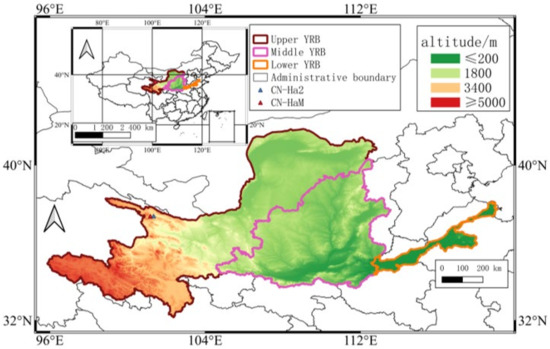
Figure 2.
The geographical location of the Yellow River Basin.
2.2.2. Data Sources
One of the advantages of the GEE platform is that many datasets are already included and data can be easily managed through processing with Python or JavaScript codes [45]. As indicated in the framework, different datasets can be used to calculate ET and WUE. This study used three different reanalysis datasets (ERA5, FLDAS, and GLDAS) as the input of three required variables for the MEP method. The Gross Primary Productivity (GPP) product was used to calculate WUE. We employed the Landcover dataset to study changes in ET and WUE values across different land use types. Table 1 provides the GEE index for these datasets as well as band and unit information. In addition to these GEE datasets, two EC sites (CN-Ha2 and CN-HaM) were selected from FLUXNET 2015 to validate the MEP method in the YRB.

Table 1.
Details of GEE datasets.
Meteorological Variables from Different Datasets
Taking advantage of the GEE platform, we selected different variables required by the MEP method (surface net solar radiation, surface (skin) temperature, and specific humidity) from ERA5, FLDAS, and GLDAS to consider the impact of data sources on the uncertainty of ET and WUE values in the YRB. These three reanalysis datasets were selected because they have the advantages of providing an array of atmospheric variables and facilitating the collection of different variables. In addition, the temporal and spatial resolution of these datasets can be referred to from the GEE platform (shown in Table 1).
ERA5 monthly average [56] is a reanalysis dataset provided by the European Centre for Medium-Range Weather Forecasts (ECMWF) which contains a consistent view of the evolution of land variables over several decades at an enhanced resolution compared to ERA5. As described by the ECMWF, ERA5 combines model data with observations from across the world into a globally complete and consistent dataset using the laws of physics.
The Famine Early Warning Systems Network (FEWS NET) Land Data Assimilation System (FLDAS) dataset was designed to help developing countries conduct food security assessments with scarce data. It includes information on many climate-related variables, including water content, humidity, average soil temperature, total precipitation, etc.
The Global Land Data Assimilation System (GLDAS) [57] ingests satellite and ground-based observational data products. It uses advanced surface simulation and data assimilation technology to generate the optimal surface state and flux fields. The GLDAS dataset has a three-hour time scale and a 0.25° spatial resolution, necessitating the unification of variables into a consistent scale with ERA5 and FLDAS [58].
Gross Primary Productivity
Following the definition of WUE used in this study, the GPP product was selected from the GEE platform. The MOD17A2H V6 GPP product is a cumulative eight-day composite with a 500-m spatial resolution provided by NASA LP DAAC at the USGS EROS Center; the details of this dataset are shown in Table 1. The product is based on the radiation-use efficiency concept. Therefore, it can be potentially used as an input to data models in order to calculate terrestrial energy, carbon, water cycle processes, the and biogeochemistry of vegetation. To keep the time resolution consistent, we converted eight-day data into monthly data by averaging, similar to [38].
The Landcover Dataset
This study selected land cover datasets to investigate linkage between land cover and WUE changes. The MCD12Q1 V6 dataset, obtained by supervised classification using MODIS Terra and Aqua datasets, provides annual global land cover data under six different classification methods. The MCD12Q1 V6 data are believed to result from supervised classification subjected to additional post-processing and combined with prior knowledge and auxiliary information to refine further specific categories [59]. The GEE platform provided this dataset as the classification data under the Annual International Geosphere-Biosphere Programmer (IGBP) classification (as shown in Table A1 in Appendix A), which were used in this study (https://developers.google.com/earth-engine/datasets/catalog/MODIS_006_MCD12Q1, accessed on 9 December 2021).
FLUXNET 2015
The FLUXNET 2015 dataset provides measured variables (including energy, water, and CO2 exchange fluxes between biosphere and atmosphere, and other biological and meteorological measurement variables [60]) from as many as 200 sites, which can be used for validation of ET estimates. Two EC sites located in the YRB, Haibei Shrubland (CN-Ha2) (37.61 N, 101.33 E) and Haibei Alpine Tibet Site (CN-HaM) (37.37 N, 101.18 E), were selected in this study. The raw data from the EC sites were corrected and their quality assessed following Reba et al. [61].
3. Results
3.1. Validation of Framework for Actual ET
As indicated by the outputs of the “GEEMEP” package, the estimated actual ET using the “GEEMEP” package with the MEP method had high accuracy compared with observed EC values. Comparing the simulated ET to the proposed framework and the observed fluxes in EC sites shows acceptable performance by the actual ET values with three input datasets (ERA5, FLDAS, and GLDAS) (Figure 3). The relative error statistical indexes confirmed the performance of these ET outputs; R2 ranged from 0.84~0.95 and 0.91–0.94 at Ha2 and HaM sites, and values of slope were close to 1. Based on the NRMSE, the best fit for ET estimation was obtained with MEP-FLDAS, with less than 15% of the range of ET. The ranges of NRMSE values obtained by the three models can be considered acceptable compared to the similar performance of estimation using satellite remote sensing data compared with EC data [62].
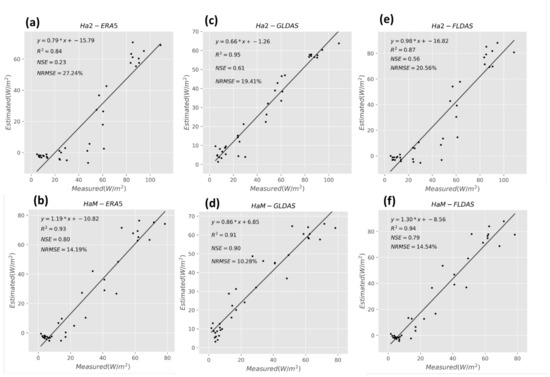
Figure 3.
Scatter plots of observations and estimations of latent heat flux using MEP methodology (ERA5: (a,b); GLDAS: (c,d); FLDAS: (e,f)).
3.2. Spatial–Temporal Variations of Actual ET in the YRB
The proposed framework has the facility to provide the spatial–temporal variations of actual ET in the YRB. The multi-year mean actual ET values obtained by three different input data sources were observed to be in a similar spatial distribution in the YRB (Figure 4a,c,e). The actual ET values are high in the southeast YRB and low in the northwest YRB, with the multi-year (2001–2020) mean annual values of ET in the YRB 394 mm/a, 445 mm/a, and 390 mm/a, respectively, for the MEP-ERA5, MEP-FLDAS, and MEP-GLDAS outputs. For the sub-basins, the actual ET values in the middle YRB and lower YRB are significantly higher than those in the upper YRB. However, the trends of actual ET during 2001–2020 are not consistent (Figure 4b,d,f).
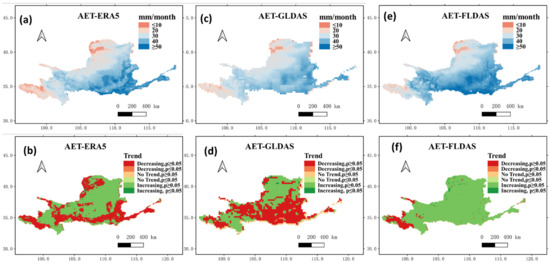
Figure 4.
Spatial distribution (a–e) and trends (b–f) of monthly mean values of actual ET in the YRB with three different input data sources, ERA5: (a,b); GLDAS: (c,d); FLDAS: (e,f).
The annual and monthly variations of simulated actual ET values with three different input data sources are shown in Figure 5. The multi-year mean annual values of actual ET in upper YRB, middle YRB, and lower YRB are 350 mm/a, 474 mm/a, and 385 mm/a, respectively. Annual mean actual ET values in the upper and middle YRB increased during the past 20 years (Figure 5a,b). Significant seasonal effects appeared in the monthly variations in the mean values of actual ET, as the maximum values of actual ET appear in July/August and the minimum values appear in January/December. Among the different sub-basins in the YRB, the middle YRB has the highest monthly mean values of actual ET compared with the upper and lower YRB. In addition, the differences between different simulations are shown in Figure 5 as shadows in the figures, indicating larger differences in the lower YRB than in the upper and middle YRB under the three different input data sources. The simulated actual ET values with three different input data sources showed large differences in the summer (Figure 5d,e,f).

Figure 5.
The annual (a–c) and monthly (d–f) variations in the mean actual ET estimated by MEP method with three different data sources (ERA5, GLDAS, and FLDAS) in sub-basins of the YRB; Upper YRB: (a,d); Middle YRB: (b,e); Lower YRB: (c,f).
3.3. Spatial–Temporal Variations of WUE in the YRB
The multi-year mean monthly WUE values were obtained as a definition with three different data sources from 2001 to 2020, and their spatial distribution is shown in Figure 6. The mean ecosystem WUE values in the YRB with the three different data sources (ERA5, FLDAS, and GLDAS) are very close (0.90 gC/m2/mm, 0.80 gC/m2/mm, and gC/m2/mm). The spatial distribution of these WUE values is characterized by being high in the east, low in the west, high in the south, and low in the north. The highest values of WUE appear in the Guanzhong Plain, the northeast section of the Qilian Mountains, and the middle and lower reaches of the coastal areas. In contrast, the lowest values appear in the south Inner Mongolia Plateau and the upper reaches of the Qinghai–Tibet Plateau. As the definition of WUE is related to GPP and ET, the spatial distribution of GPP (as shown in Figure A1 and Figure A2 in supplement files) is vital for WUE. The trends of WUE values were identified by Mann–Kendall Test, and the results show a significant upward trend in most of the YRB during the past 20 years (Figure 6b,d,f). These changes in WUE values may be due to both the actual ET and GPP trends (Table 2 shows the multi-year mean values and slopes of ET, GPP, and WUE in the different sub-basins of the YRB); WUE values in the Lower YRB show the largest trends among the three sub-regions.
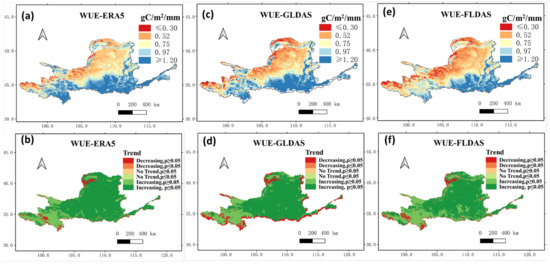
Figure 6.
Spatial distribution (a–e) and trends (b–f) of multiple years’ mean values of Water Use Efficiency (WUE) in the YRB with three different input data sources, ERA5: (a,b); GLDAS: (c,d); FLDAS: (e,f).

Table 2.
The multi-year (from 2001 to 2020) mean values and slopes of AET, GPP, and WUE in the different sub-basins of YRB.
The WUE values show large differences between the different sub-basins; the WUE values of the upper, middle, and lower YRB are 0.61 gC/m2/mm, 1.01 gC/m2/mm, and 1.44 gC/m2/mm, respectively, with mean values by outputs with three different data sources. It can be seen that the WUE in the different sub-basins of the YRB has increased significantly in the past 20 years (Figure 7a–c). The average annual growth rates are 2.4%, 3.1%, and 2.1%, respectively, while the 20-year cumulative growth rates are 48.6%, 63.1%, and 42.1%, respectively. In addition, it is obvious that the WUE values simulated by different data sources are more discrete in the lower YRB, with the highest values simulated by GLDAS and lowest by ERA5 (Figure 7d–f).
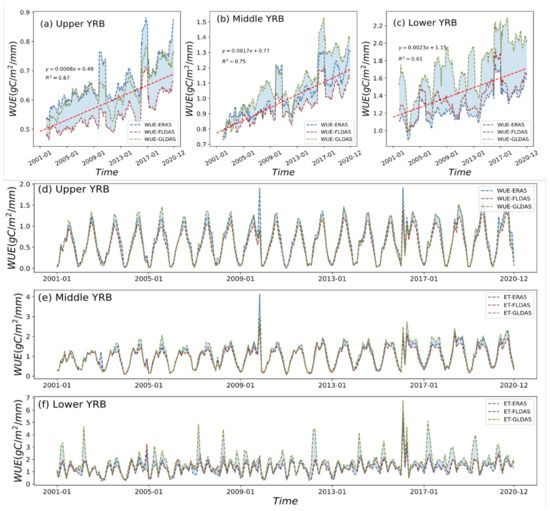
Figure 7.
The annual (a–c) and monthly (d–f) variations in the mean WUE with three different data sources (ERA5, GLDAS, and FLDAS) in sub-basins of the YRB; Upper YRB: (a,d); Middle YRB: (b,e); Lower YRB: (c,f).
3.4. Linkage of WUE Variations and Land-Use Changes
3.4.1. Land-Use Changes in the YRB
To investigate the impacts of land-use changes on ecosystem WUE, land-use changes were accounted for in tables and shown as a land cover transfer matrix. Four types of land cover, as Grasslands (G), Croplands (C), Deciduous Broadleaf Forests (DBF), and Barren (B), showed the largest area proportion in the YRB. The most common land use cover transfers during the past 20 years were areas converted from G to C and DBF, 16704.9 km2 and 1690.3 km2, respectively, in 2001–2010 and 5904.1 km2 and 170.5 km2, respectively, in 2010–2018 (Figure 8a,b).
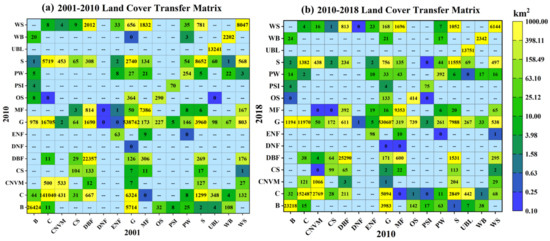
Figure 8.
The land cover transfer matrix in the Yellow River Basin for 2001–2010 (a) and 2010–2018 (b).
3.4.2. Linkage of WUE Variations and Land-Use Changes
As shown in Figure 9, five land-cover types (forest land, high coverage grassland, shrub, farmland, and wetland) have higher WUE values while the other four types (low coverage grassland, construction land, desert, and glacier) have lower WUE values. The Grasslands, with the highest area proportion, have a relatively concentrated distribution interval; the mean values are 0.77 gC/m2/mm, 0.65 gC/m2/mm, and 0.74 gC/m2/mm, respectively, for ERA5, FLDAS, and GLDAS. The mean values of the WUE in Croplands, which is the land use type with the second-highest area proportion, are 1.13 gC/m2/mm, 1.07 gC/m2/mm2, and 1.28 gC/m2/mm, respectively, for ERA5, FLDAS, and GLDAS.
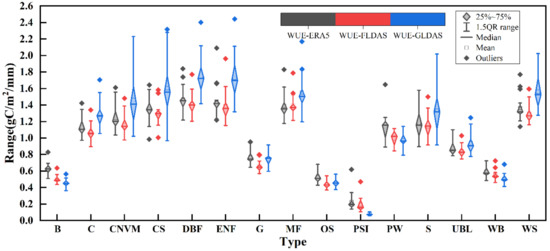
Figure 9.
Box plots of the annual mean WUE values in different land-use types in the YRB.
As indicated by the range of WUE values in Figure 9, it appears that the estimations of WUE values obtained by inputting GLDAS for a specific land use type have larger ranges. The ranges in Figure 9 and the land cover transfer matrix shown in Figure 8 indicate the linkage between WUE variations and land-use changes. It should be noted that the “CNVM” (Cropland/Natural Vegetation Mosaics) and “S” (Savannas) had large variations in both WUE, especially WUE-GLDAS, and land-use changes, which may indicate large water resource variations in the YRB. This result is confirmed by the presentation of the complicated variations in WUE values in the YRB and northwestern regions of China by Zhu et al. [8].
3.4.3. Relationship between WUE Variations and Land-Use Changes
Based on the linkage between WUE variations and land-use changes, the relationship between the four types of land cover with the largest area proportion, Grasslands (G), Croplands (C), Deciduous Broadleaf Forests (DBF), and Barren (B), were investigated; Figure A3 in the supplement files shows the proportion and mean annual growth rates of the different land cover types. In Figure 10, the scatter plot shows the relationship between these four land cover types and Water Use Efficiency (WUE) in the YRB. The WUE variations have a good relationship with most of the land-use changes, indicating that land-use changes can lead to WUE variations. This relationship may be used as evidence for the changes in WUE during the past 20 years, in which WUE values appear to increase significantly in the YRB from 2001 to 2020. It can be inferred that the transformation from G to C and DBF improved WUE values in the YRB, as well as that the changes in WUE value have a negative correlation with B and G and a positive one with C and DBF (Figure 10). These results show that WUE can react in diverse patterns across different land cover types.
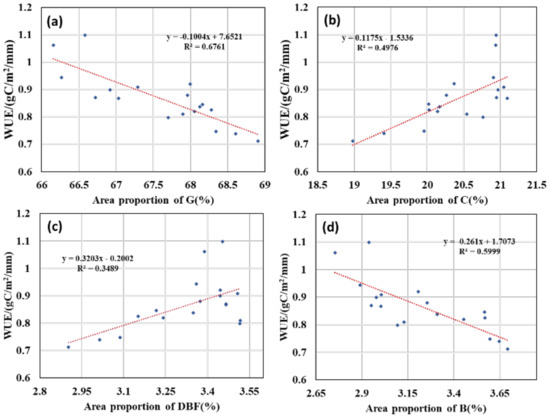
Figure 10.
Relationship between four different land cover types and Water Use Efficiency (WUE) in the YRB: (a) Grasslands (G); (b) Croplands (C); (c) Deciduous Broadleaf Forests (DBF); (d) Barren (B).
4. Discussion
4.1. Application of the Proposed Framework
The computation of ET requires complex data sources as input, which has caused great obstacles to water resources management. As a cloud computing platform, the GEE platform integrates a large amount of data such as climate reanalysis data and remote sensing data, which is convenient for the computation of evapotranspiration. In order to facilitate fast WUE investigation, we encapsulated the proposed framework into a python package named “GEEMEP” (available from the authors upon request). After installation, users only need to enter the region, time, and resolution to automatically calculate the corresponding ET, and can optionally output the corresponding WUE data. While the computation time using the GEE varies depending on the complexity of the processing task and the amount of computational resources available on the GEE servers; is appears to be an efficient tool for water resource management, especially on a large scale.
Using the “GEEMEP” package shows that the WUE values can be quickly obtained using the proposed framework. It is possible to observe the impacts of WUE variations under different input data sources by employing various datasets offered by GEE. As shown in Figure 5 and Figure 7, the ET values are high with FLDAS and low with GLDAS, while for WUE the trend is the opposite. Here, the framework proposed in this study may be a good illustration to answer the question of the computational model mismatch [37] as the MEP method can handle different scales from site and field scales [28,29] to regional scales as well as couple into the GEE platform. Although the multiple sources of uncertainty in actual ET have been discussed by several studies [12], the results in this study indicate the impacts of different data sources should be recognized as well.
This study reveals the role of land use cover changes in WUE variations. By implementing “GEEMEP”, we found that the GPP and WUE values increased significantly in different sub-basins of the YRB (slope > 0 and p < 0.05, as shown in Table 2). For example, from 2001 to 2018 the area of Grasslands transformed into Croplands and Deciduous Broadleaf Forests was 21799 km2 and 1780 km2, respectively (as shown in Figure 10), which plays a dominant role in the increase in GPP and WUE in the Yellow River Basin.
4.2. Accuracy Assessment of WUE
It should be noted that the definition of WUE in this study relies on the accuracy of the estimated AET. The accuracy assessment of WUE has been taken into account by comparison with the literature. This study provides WUE values comparable to those summarized by Zhu et al. [8] from the literatures, which provides WUE values for 2000–2006 of 0.66–2.01 gC/m2/mm for MF (Mixed Forests), 0.27–2.39 gC/m2/mm for G (Grassland), and 0.17–1.53 gC/m2/mm for OS (Open Shrublands).
Several other factors may lead to uncertainty in ET simulation, such as the reclassification of landcover and the inherent uncertainty related to GEE datasets. However, it is advantageous to employ the MEP method to obtain the actual ET, as this method avoids the sensitivity of ET estimation related to land cover types [12]. Therefore, the results of large-scale estimation of actual ET and WUE support the conclusion that establishing perennial vegetation cover and terrace farming can be effective measures to improve vegetation coverage and water use efficiency in the ecosystem of the YRB.
Many factors affect WUE variations on regional scales [2,41]; therefore, it should be both interesting and easy to employ the GEE platform to investigate different WUE variation factors. More refined data may be helpful in obtaining a more robust estimation in large regions. However, employing fine datasets depends on the GEE platform’s offer of additional such datasets. Though we have shown the functionality of the proposed framework for the YRB in this study, more results and validations for various river basins such as the Yangtze River Basin, Haihe River Basin, Heihe River Basin, etc., could be obtained as well.
4.3. Implications
A wider implication of this study is the use of the proposed framework to investigate WUE variations in large regions. The findings of this study may be helpful for projecting water resource management, agricultural management, and practices necessitated by human activities and climate change.
However, different definitions of WUE may lead to well-understood WUE variations. For example, evapotranspiration- and transpiration-based ecosystem WUE have been reported to be discrepant responses to meteorological changes [1]. Furthermore, the relationship between vegetation changes and ecosystem WUE is discussed by [9], and they indicate that ET partitioning may cause variations in WUE. Therefore, we suggest further discussion of the relationship between ET partitioning and WUE variation in future work.
5. Conclusions
With ongoing changes in land cover, it has become important to investigate the impact of land cover changes on ecosystem WUE. Moreover, it is crucial to understand long-term water availability and assess water-saving strategies. In order to employ the advantages of the GEE platform, a python calculation package named “GEEMEP” based on the GEE platform and MEP method was proposed in this study.
The YRB, the second-largest river basin in China, was selected as the study area. The actual ET was calculated by inputting the start and end time, regions, and spatial–temporal resolution, then transferred into the WUE values. The implementation processes of the “GEEMEP” package were shown to be fluent, and the flux EC datasets verified the accuracy of the package. The results showed a similar spatial distribution in actual ET values, lowest in the Southeastern and highest in the Northwestern YRB, with all three different input datasets originating from the GEE platform (ERA5, FLDAS, and GLDAS). This is a good illustration of the advantages of employing the GEE platform for WUE estimation, and, the MEP method is validated in this framework as well.
When coupling the GEE platform and MEP method to facilitate the estimation of WUE values in the YRB, the variations WUE showed large spatial–temporal changes in 2001–2020. Furthermore, the WUE values showed a significant increasing trend and a cumulative growth rate of about 56% during the past 20 years, which may relate to the changes in GPP in the YRB. In addition, the role of land use cover was revealed in this study. Investigating the linkage between WUE variations and land use cover changes, the dominant factors leading to these WUE variations appear to be the transition of Grasslands into other land-use types. These advances align well with the goals of applied science in supporting the implementation of Earth observations into better-informed management of water resources.
Fine datasets may appear in the GEE platform and improve the abilities of the proposed framework with respect to water resource management. Our results suggest that the usability of the GEE platform coupled with the MEP method offers new possibilities for advancing understanding of water exchange and water resource management. This study helps to promote understanding of the impacts of data sources on WUE variations, and provides details on spatial–temporal variations in actual ET and WUE in the YRB.
Supplementary Materials
A brief introduction to the “GEEMEP” package can be found in the Supplemental Materials. The full package code and examples can be obtained from the authors upon reasonable request. The following supporting information can be download at: https://www.mdpi.com/article/10.3390/rs14051065/s1, Table S1: The versions of Python and main modules are applied in the “GEEMEP” package.
Author Contributions
Conceptualization, H.S.; Data curation, J.X.; Formal analysis, Y.Y. and M.L. (Mengge Lu); Methodology, H.S. and L.C.; Resources, H.S. and J.X.; Software, L.C.; Supervision, H.Q., J.X., and D.Y.; Validation, L.C.; Writing—original draft, H.S.; Writing—review & editing, M.L. (Mengge Lu), H.Q., B.Z., and M.L. (Mengtian Lu). All authors have read and agreed to the published version of the manuscript.
Funding
This research was primarily funded by the Ministry of Science and Technology of China (2019FY00205) (H.S.). The authors acknowledge funding from the NSFC project (51879110, 52079055, 52011530128, and 42071259). H.S. acknowledges funding from the NSFC-STINT project (No. 202100-3211), and J.X acknowledges funding from the Youth Innovation Promotion Association of the Chinese Academy of Sciences (2019430).
Institutional Review Board Statement
Not applicable.
Informed Consent Statement
Not applicable.
Data Availability Statement
The GPP datasets are available from Google Earth Engine (GEE) at https://developers.google.com/earth-engine/datasets/catalog/MODIS_006_MOD17A2H (accessed on 9 December 2021). The ERA5 datasets are available from GEE at https://developers.google.com/earth-engine/datasets/catalog/ECMWF_ERA5_LAND_MONTHLY (accessed on 9 December 2021). The FLDAS datasets are available from GEE at https://developers.google.com/earth-engine/datasets/catalog/NASA_FLDAS_NOAH01_C_GL_M_V001 (accessed on 9 December 2021). The GLDAS are available from GEE at https://developers.google.com/earth-engine/datasets/catalog/NASA_GLDAS_V021_NOAH_G025_T3H (accessed on 9 December 2021). The land cover datasets are available from GEE at https://developers.google.com/earth-engine/datasets/catalog/MODIS_006_MCD12Q1 (accessed on 9 December 2021). The FLUXNET 2015 dataset are available at https://fluxnet.org/data/fluxnet2015-dataset (accessed on 9 December 2021).
Acknowledgments
The authors extend their gratitude to the developers and data providers of Google Earth Engine. The authors are thankful to the scientists and technicians worldwide and coordination among teams from regional networkers who have contributed to the FLUXNET Dataset.
Conflicts of Interest
The authors declare no conflict of interest.
Abbreviations
The following abbreviations are used in this manuscript:
| WUE | Water use efficiency |
| ET | Evapotranspiration |
| AET | Actual evapotranspiration |
| MEP | Maximum Entropy Production |
| GEE | Google Earth Engine |
| YRB | Yellow River Basin |
| EC | Eddy Covariance |
| SEB | Surface energy balance |
| GEEMEP | Coupling the MEP method and utilizing GEE |
| GDP | Gross Domestic Product |
| GPP | Gross Primary Production |
| ERA5 | ERA5-Land Monthly Averaged—ECMWF Climate Reanalysis |
| FLDAS | Famine Early Warning Systems Network (FEWS NET) Land Data Assimilation System |
| GLDAS-2.1 | Global Land Data Assimilation System |
| MOD17A2H-V6 | Terra Gross Primary Productivity 8-Day Global 500M |
| MCD12Q1-V6 | MODIS Land Cover Type Yearly Global 500m |
| QTP | Qinghai Tibet Plateau |
| IMP | Inner Mongolia Plateau |
| LP | Loess Plateau |
| NCP | North China Plain |
| YRCC | Yellow River Conservancy Commission |
| FEWS NET | The Famine Early Warning Systems Network |
| IGBP | International Geosphere-Biosphere Programmer |
| CN-Ha2 | Haibei Shrubland |
| CN-HaM | Haibei Alpine Tibet Site |
| NSE | Nash–Sutcliffe efficiency |
| NRMSE | Normalized Root Mean Squared Error |
Appendix A
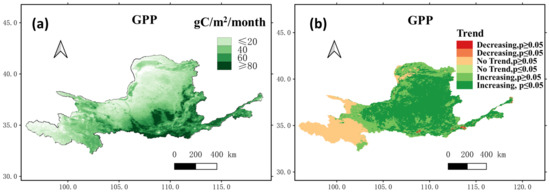
Figure A1.
(a) Spatial variations and (b) trends in monthly mean GPP in the YRB; sourced from MOD17A2H.
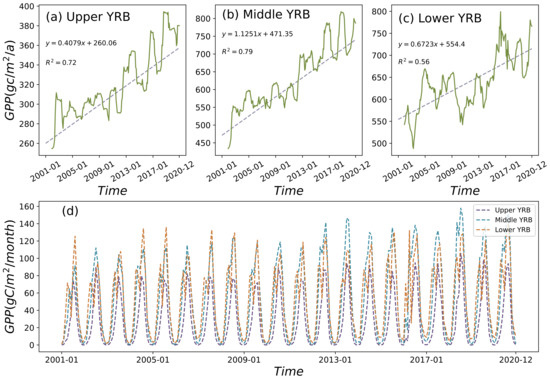
Figure A2.
The annual (a–c) and monthly (d) variations in mean GPP values (sourced from MOD17A2H) in the sub-basins of the YRB; Upper YRB: (a); Middle YRB: (b); Lower YRB: (c).

Figure A3.
The proportions (a) and mean annual growth rates (b) of different land cover types in the YRB. The four different land cover types are Grasslands (G), Croplands (C), Deciduous Broadleaf Forests (DBF), and Barren (B).

Table A1.
Land cover types, following the Annual International Geosphere–Biosphere Programme (IGBP) classification.
Table A1.
Land cover types, following the Annual International Geosphere–Biosphere Programme (IGBP) classification.
| Value | Description | Abbreviation |
|---|---|---|
| 1 | Evergreen Needleleaf Forests: dominated by evergreen conifer trees (canopy > 2 m). Tree cover > 60%. | ENF |
| 2 | Evergreen Broadleaf Forests: dominated by evergreen broadleaf and palmate trees (canopy > 2 m). Tree cover > 60%. | EBF |
| 3 | Deciduous Needleleaf Forests: dominated by deciduous needleleaf (larch) trees (canopy > 2 m). Tree cover > 60%. | DNF |
| 4 | Deciduous Broadleaf Forests: dominated by deciduous broadleaf trees (canopy > 2 m). Tree cover > 60%. | DBF |
| 5 | Mixed Forests: dominated by neither deciduous nor evergreen (40–60% of each) tree type (canopy > 2 m). Tree cover > 60%. | MF |
| 6 | Closed Shrublands: dominated by woody perennials (1–2 m height) > 60% cover. | CS |
| 7 | Open Shrublands: dominated by woody perennials (1–2 m height) 10–60% cover. | OS |
| 8 | Woody Savannas: tree cover 30–60% (canopy > 2 m). | WS |
| 9 | Savannas: tree cover 10–30% (canopy > 2 m). | S |
| 10 | Grasslands: dominated by herbaceous annuals (<2 m). | G |
| 11 | Permanent Wetlands: permanently inundated lands with 30–60% water cover and > 10% vegetated cover. | PW |
| 12 | Croplands: at least 60% of the area is cultivated cropland. | C |
| 13 | Urban and Built-up Lands: at least 30% impervious surface area including building materials, asphalt and vehicles. | UBL |
| 14 | Cropland/Natural Vegetation Mosaics: mosaics of small-scale cultivation 40–60% with natural tree, shrub, or herbaceous vegetation. | CNVM |
| 15 | Permanent Snow and Ice: at least 60% of the area is covered by snow and ice for at least ten months of the year. | PSI |
| 16 | Barren: at least 60% of the area is non-vegetated barren (sand, rock, soil) areas with less than 10% vegetation. | B |
| 17 | Water Bodies: at least 60% of the area is covered by permanent water bodies. | WB |
Notes: Not all types exist in this study area.
References
- Gu, C.; Tang, Q.; Zhu, G.; Ma, J.; Gu, C.; Zhang, K.; Sun, S.; Yu, Q.; Niu, S. Discrepant responses between evapotranspiration-and transpiration-based ecosystem water use efficiency to interannual precipitation fluctuations. Agric. For. Meteorol. 2021, 303, 108385. [Google Scholar] [CrossRef]
- Zhang, L.; Xiao, J.; Zheng, Y.; Li, S.; Zhou, Y. Increased carbon uptake and water use efficiency in global semi-arid ecosystems. Environ. Res. Lett. 2020, 15, 034022. [Google Scholar] [CrossRef]
- Niu, S.; Xing, X.; Zhang, Z.; Xia, J.; Zhou, X.; Song, B.; Li, L.; Wan, S. Water-use efficiency in response to climate change: From leaf to ecosystem in a temperate steppe. Glob. Change Biol. 2011, 17, 1073–1082. [Google Scholar] [CrossRef]
- Beer, C.; Ciais, P.; Reichstein, M.; Baldocchi, D.; Law, B.E.; Papale, D.; Soussana, J.F.; Ammann, C.; Buchmann, N.; Frank, D.; et al. Temporal and among-site variability of inherent water use efficiency at the ecosystem level. Glob. Biogeochem. Cycles 2009, 23, e2008GB003233. [Google Scholar] [CrossRef]
- Chapin, F.S.; Matson, P.A.; Vitousek, P. Principles of Terrestrial Ecosystem Ecology; Springer: New York, NY, USA, 2011. [Google Scholar]
- DeLucia, E.H.; Heckathorn, S.A. The effect of soil drought on water-use efficiency in a contrasting Great Basin desert and Sierran montane species. Plant Cell Environ. 1989, 12, 935–940. [Google Scholar] [CrossRef]
- Lasch, P.; Lindner, M.; Erhard, M.; Suckow, F.; Wenzel, A. Regional impact assessment on forest structure and functions under climate change—The Brandenburg case study. For. Ecol. Manag. 2002, 162, 73–86. [Google Scholar] [CrossRef]
- Zhu, Q.; Jiang, H.; Peng, C.; Liu, J.; Wei, X.; Fang, X.; Liu, S.; Zhou, G.; Yu, S. Evaluating the effects of future climate change and elevated CO2 on the water use efficiency in terrestrial ecosystems of China. Ecol. Model. 2011, 222, 2414–2429. [Google Scholar] [CrossRef]
- Jing, Z.; Cheng, L.; Zhang, L.; Wang, Y.-P.; Liu, P.; Zhang, X.; Wang, Q. The dependence of ecosystem water use partitioning on vegetation productivity at the inter-annual time scale. J. Geophys. Res. Atmos. 2021, 126, e2020JD033756. [Google Scholar] [CrossRef]
- Katul, G.G.; Oren, R.; Manzoni, S.; Higgins, C.; Parlange, M.B. Evapotranspiration: A process driving mass transport and energy exchange in the soil-plant-atmosphere-climate system. Rev. Geophys. 2012, 50, e2011rg000366. [Google Scholar] [CrossRef] [Green Version]
- Duan, Z.; Bastiaanssen, W. Evaluation of three energy balance-based evaporation models for estimating monthly evaporation for five lakes using derived heat storage changes from a hysteresis model. Environ. Res. Lett. 2017, 12, 024005. [Google Scholar] [CrossRef] [Green Version]
- Cao, M.; Wang, W.; Xing, W.; Wei, J.; Chen, X.; Li, J.; Shao, Q. Multiple sources of uncertainties in satellite retrieval of terrestrial actual evapotranspiration. J. Hydrol. 2021, 601, 126642. [Google Scholar] [CrossRef]
- Cook, D.R. Energy Balance Bowen Ratio (EBBR) Handbook. 2005. Available online: https://www.osti.gov/biblio/1020562-energy-balance-bowen-ratio-station-ebbr-instrument-handbook (accessed on 9 December 2021).
- Goss, M.J.; Ehlers, W. The role of lysimeters in the development of our understanding of soil water and nutrient dynamics in ecosystems. Soil Use Manag. 2009, 25, 213–223. [Google Scholar] [CrossRef]
- Su, Z. The Surface Energy Balance System (SEBS) for estimation of turbulent heat fluxes. Hydrol. Earth Syst. Sci. 2002, 6, 85–100. [Google Scholar] [CrossRef]
- Wang, W.; Li, J.; Yu, Z.; Ding, Y.; Xing, W.; Lu, W. Satellite retrieval of actual evapotranspiration in the Tibetan Plateau: Components partitioning, multidecadal trends and dominated factors identifying. J. Hydrol. 2018, 559, 471–485. [Google Scholar] [CrossRef]
- Wang, K.; Dickinson, R.E. A review of global terrestrial evapotranspiration: Observation, modeling, climatology, and climatic variability. Rev. Geophys. 2012, 50, e2011rg000373. [Google Scholar] [CrossRef]
- Wilson, K.; Goldstein, A.; Falge, E.; Aubinet, M.; Baldocchi, D.; Berbigier, P.; Bernhofer, C.; Ceulemans, R.; Dolman, H.; Field, C.; et al. Energy balance closure at FLUXNET sites. Agric. For. Meteorol. 2002, 113, 223–243. [Google Scholar] [CrossRef] [Green Version]
- Elnashar, A.; Wang, L.; Wu, B.; Zhu, W.; Zeng, H. Synthesis of global actual evapotranspiration from 1982 to 2019. Earth Syst. Sci. Data 2021, 13, 447–480. [Google Scholar] [CrossRef]
- Oki, T.; Kanae, S. Global hydrological cycles and world water resources. Science 2006, 313, 1068–1072. [Google Scholar] [CrossRef] [Green Version]
- Rodell, M.; Beaudoing, H.K.; L’Ecuyer, T.S.; Olson, W.S.; Famiglietti, J.S.; Houser, P.R.; Adler, R.; Bosilovich, M.G.; Clayson, C.A.; Chambers, D.; et al. The observed state of the water cycle in the early twenty-first century. J. Clim. 2015, 28, 8289–8318. [Google Scholar] [CrossRef]
- Trenberth, K.E.; Smith, L.; Qian, T.; Dai, A.; Fasullo, J. Estimates of the global water budget and its annual cycle using observational and model data. J. Hydrometeorol. 2007, 8, 758–769. [Google Scholar] [CrossRef]
- Jepsen, S.; Harmon, T.C.; Guan, B. Analyzing the Suitability of Remotely Sensed ET for Calibrating a Watershed Model of a Mediterranean Montane Forest. Remote Sens. 2021, 13, 1258. [Google Scholar] [CrossRef]
- Zhang, K.; Zhu, G.; Ma, J.; Yang, Y.; Shang, S.; Gu, C. Parameter analysis and estimates for the MODIS evapotranspiration algorithm and multiscale verification. Water Resour. Res. 2019, 55, 2211–2231. [Google Scholar] [CrossRef]
- Sun, H.; Yang, Y.; Wu, R.; Gui, D.; Xue, J.; Liu, Y.; Yan, D. Improving estimation of cropland evapotranspiration by the Bayesian model averaging method with surface energy balance models. Atmosphere 2019, 10, 188. [Google Scholar] [CrossRef] [Green Version]
- Yang, Z.; Tian, J.; Li, W.; Su, W.; Guo, R.; Liu, W. Spatio-temporal pattern and evolution trend of ecological environment quality in the Yellow River Basin. Acta Ecol. Sin. 2021, 41, 7627–7636. [Google Scholar]
- Wang, J.; Bras, R.L. A model of evapotranspiration based on the theory of maximum entropy production. Water Resour. Res. 2011, 47, e2010wr009392. [Google Scholar] [CrossRef]
- Hajji, I.; Nadeau, D.F.; Music, B.; Anctil, F.; Wang, J. Application of the maximum entropy production model of evapotranspiration over partially vegetated water-limited land surfaces. J. Hydrometeorol. 2018, 19, 989–1005. [Google Scholar] [CrossRef]
- El Sharif, H.; Zhou, W.; Ivanov, V.; Sheshukov, A.; Mazepa, V.; Wang, J. Surface energy budgets of Arctic tundra during growing season. J. Geophys. Res. Atmos. 2019, 124, 6999–7017. [Google Scholar] [CrossRef]
- Xu, D.; Agee, E.; Wang, J.; Ivanov, V.Y. Estimation of evapotranspiration of Amazon rainforest using the maximum entropy production method. Geophys. Res. Lett. 2019, 46, 1402–1412. [Google Scholar] [CrossRef]
- Timmermans, W.J.; Kustas, W.P.; Anderson, M.C.; French, A.N. An intercomparison of the surface energy balance algorithm for land (SEBAL) and the two-source energy balance (TSEB) modeling schemes. Remote Sens. Environ. 2007, 108, 369–384. [Google Scholar] [CrossRef]
- Bastiaanssen, W.G.M.; Menenti, M.; Feddes, R.A.; Holtslag, A.A.M. A remote sensing surface energy balance algorithm for land (SEBAL). 1. Formulation. J. Hydrol. 1998, 212–213, 198–212. [Google Scholar] [CrossRef]
- Khan, M.S.; Liaqat, U.W.; Baik, J.; Choi, M. Stand-alone uncertainty characterization of GLEAM, GLDAS and MOD16 evapotranspiration products using an extended triple collocation approach. Agric. For. Meteorol. 2018, 252, 256–268. [Google Scholar] [CrossRef]
- Vinukollu, R.K.; Wood, E.F.; Ferguson, C.R.; Fisher, J.B. Global estimates of evapotranspiration for climate studies using multi-sensor remote sensing data: Evaluation of three process-based approaches. Remote Sens. Environ. 2011, 115, 801–823. [Google Scholar] [CrossRef]
- Yao, Y.; Liang, S.; Cheng, J.; Liu, S.; Fisher, J.B.; Zhang, X.; Jia, K.; Zhao, X.; Qin, Q.; Zhao, B.; et al. MODIS-driven estimation of terrestrial latent heat flux in China based on a modified Priestley–Taylor algorithm. Agric. For. Meteorol. 2013, 171–172, 187–202. [Google Scholar] [CrossRef]
- Kumar, L.; Mutanga, O. Google Earth Engine applications since inception: Usage, trends, and potential. Remote Sens. 2018, 10, 1509. [Google Scholar] [CrossRef] [Green Version]
- Gorelick, N.; Hancher, M.; Dixon, M.; Ilyushchenko, S.; Thau, D.; Moore, R. Google Earth Engine: Planetary-scale geospatial analysis for everyone. Remote Sens. Environ. 2017, 202, 18–27. [Google Scholar] [CrossRef]
- Li, C.C.; Zhang, Y.Q.; Shen, Y.J.; Yu, Q. Decadal water storage decrease driven by vegetation changes in the Yellow River Basin. Sci. Bull. 2020, 65, 1859–1861. [Google Scholar] [CrossRef]
- Tang, Q.; Oki, T.; Kanae, S.; Hu, H. A spatial analysis of hydro-climatic and vegetation condition trends in the Yellow River basin. Hydrol. Process. 2008, 22, 451–458. [Google Scholar] [CrossRef]
- Tang, Q.; Vivoni, E.R.; Muñoz-Arriola, F.; Lettenmaier, D.P. Predictability of evapotranspiration patterns using remotely sensed vegetation dynamics during the North American monsoon. J. Hydrometeorol. 2012, 13, 103–121. [Google Scholar] [CrossRef]
- Sun, H.; Bai, Y.; Lu, M.; Wang, J.; Tuo, Y.; Yan, D.; Zhang, W. Drivers of the water use efficiency changes in China during 1982–2015. Sci. Total Environ. 2021, 799, 149145. [Google Scholar] [CrossRef]
- Hu, Z.M.; Yu, G.R.; Wang, Q.F.; Zhao, F.H. Ecosystem level water use efficiency: A review. Acta Ecol. Sin. 2009, 29, 1498–1507. [Google Scholar]
- Tang, Y.; Shahnaz, S.; Wang, J. A Non-gradient Model of Turbulent Gas Fluxes over Land Surfaces. J. Geophys. Res. Atmos. 2021, 126, e2021JD034605. [Google Scholar] [CrossRef]
- Wang, J.; Bras, R.L. An extremum solution of the Monin–Obukhov similarity equations. J. Atmos. Sci. 2010, 67, 485–499. [Google Scholar] [CrossRef]
- Amani, M.; Ghorbanian, A.; Ahmadi, S.A.; Kakooei, M.; Moghimi, A.; Mirmazloumi, S.M.; Moghaddam, S.H.A.; Mahdavi, S.; Ghahremanloo, M.; Parsian, S.; et al. Google earth engine cloud computing platform for remote sensing big data applications: A comprehensive review. IEEE J. Sel. Top. Appl. Earth Obs. Remote Sens. 2020, 13, 5326–5350. [Google Scholar] [CrossRef]
- Wang, J.; Bras, R.L. A model of surface heat fluxes based on the theory of maximum entropy production. Water Resour. Res. 2009, 45, e2009WR007900. [Google Scholar] [CrossRef] [Green Version]
- Chen, Y.; Yang, K.; He, J.; Qin, J.; Shi, J.; Du, J.; He, Q. Improving land surface temperature modeling for dry land of China. J. Geophys. Res. Atmos. 2011, 116, e2011jd015921. [Google Scholar] [CrossRef]
- Bolton, D. The computation of equivalent potential temperature. Mon. Weather Rev. 1980, 108, 1046–1053. [Google Scholar] [CrossRef] [Green Version]
- Gupta, H.V.; Kling, H.; Yilmaz, K.K.; Martinez, G.F. Decomposition of the mean squared error and NSE performance criteria: Implications for improving hydrological modelling. J. Hydrol. 2009, 377, 80–91. [Google Scholar] [CrossRef] [Green Version]
- Yang, Y.; Sun, H.; Luo, H. Application of maximum entropy production model for estimation of evapotranspiration in China. Agric. Res. Arid. Areas 2020, 38, 184–191. [Google Scholar]
- Helsel, D.R.; Hirsch, R.M. Statistical Methods in Water Resources. Techniques of Water-Resources Investigations of the United States Geological Survey; United States Geological Survey: Reston, VA, USA, 2002; p. 522.
- Mann, H.B. Nonparametric tests against trend. Econometrica 1945, 13, 245–259. [Google Scholar] [CrossRef]
- Azizzadeh, M.; Javan, K. Analyzing trends in reference evapotranspiration in northwest part of Iran. J. Ecol. Eng. 2015, 16, 1–12. [Google Scholar] [CrossRef]
- Shadmani, M.; Marofi, S.; Roknian, M. Trend analysis in reference evapotranspiration using Mann-Kendall and Spearman’s Rho tests in arid regions of Iran. Water Resour. Manag. 2012, 26, 211–224. [Google Scholar] [CrossRef] [Green Version]
- Omer, A.; Zhuguo, M.; Zheng, Z.; Saleem, F. Natural and anthropogenic influences on the recent droughts in Yellow River Basin, China. Sci. Total Environ. 2020, 704, 135428. [Google Scholar] [CrossRef]
- Muñoz Sabater, J. ERA5-Land Monthly Averaged Data from 1981 to Present; Copernicus Climate Change Service (C3S), Climate Data Store (CDS) [Data Set]. 2019. Available online: https://cds.climate.copernicus.eu/cdsapp#!/dataset/10.24381/cds.68d2bb30?tab=overview (accessed on 9 December 2021).
- Rodell, M.; Houser, P.R.; Jambor, U.; Gottschalck, J.; Mitchell, K.; Meng, C.; Arsenault, K.; Cosgrove, B.; Radakovich, J.; Bosilovich, M. The global land data assimilation system. Bull. Am. Meteorol. Soc. 2004, 85, 381–394. [Google Scholar] [CrossRef] [Green Version]
- McNally, A. FLDAS noah land surface model L4 global monthly 0.1 × 0.1 degree (MERRA-2 and CHIRPS). Atmos. Compos. Water Energy Cycles Clim. Var. 2018. [Google Scholar] [CrossRef]
- Sulla-Menashe, D.; Friedl, M. MCD12Q1 MODIS/Terra+Aqua Land Cover Type Yearly L3 Llobal 500 m SIN Grid v006; NASA EOSDIS Land Processes DAAC: Sioux Falls, SD, USA, 2019. [Google Scholar]
- Pastorello, G.; Trotta, C.; Canfora, E.; Chu, H.; Christianson, D.; Cheah, Y.-W.; Poindexter, C.; Chen, J.; Elbashandy, A.; Humphrey, M.; et al. The FLUXNET2015 dataset and the ONEFlux processing pipeline for eddy covariance data. Sci. Data 2020, 7, 225. [Google Scholar] [CrossRef] [PubMed]
- Reba, M.L.; Link, T.E.; Marks, D.; Pomeroy, J. An assessment of corrections for eddy covariance measured turbulent fluxes over snow in mountain environments. Water Resour. Res. 2009, 45, e2008WR007045. [Google Scholar] [CrossRef]
- Junttila, S.; Kelly, J.; Kljun, N.; Aurela, M.; Klemedtsson, L.; Lohila, A.; Nilsson, M.B.; Rinne, J.; Tuittila, E.; Vestin, P.; et al. Upscaling northern peatland CO2 fluxes using satellite remote sensing data. Remote Sens. 2021, 13, 818. [Google Scholar] [CrossRef]
Publisher’s Note: MDPI stays neutral with regard to jurisdictional claims in published maps and institutional affiliations. |
© 2022 by the authors. Licensee MDPI, Basel, Switzerland. This article is an open access article distributed under the terms and conditions of the Creative Commons Attribution (CC BY) license (https://creativecommons.org/licenses/by/4.0/).